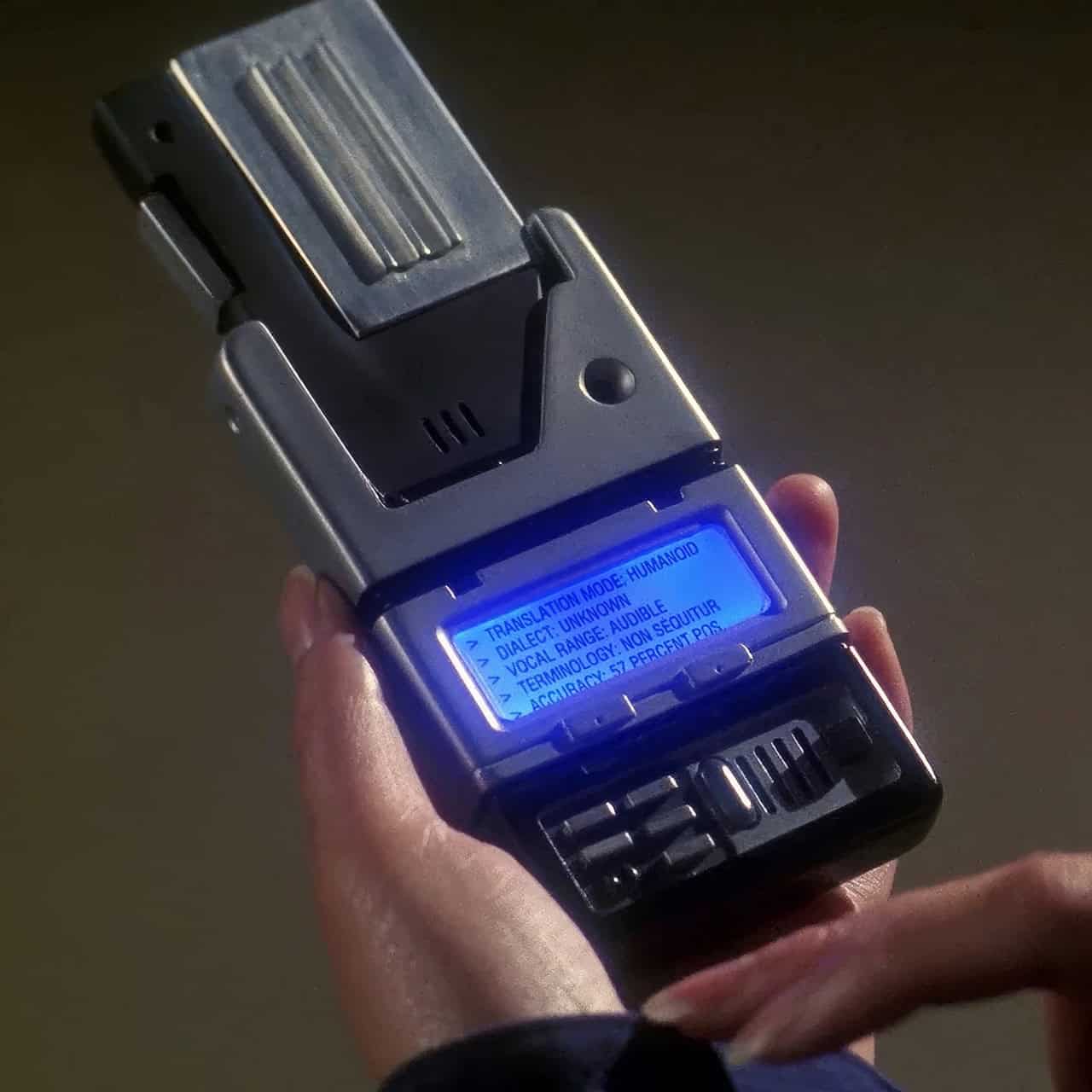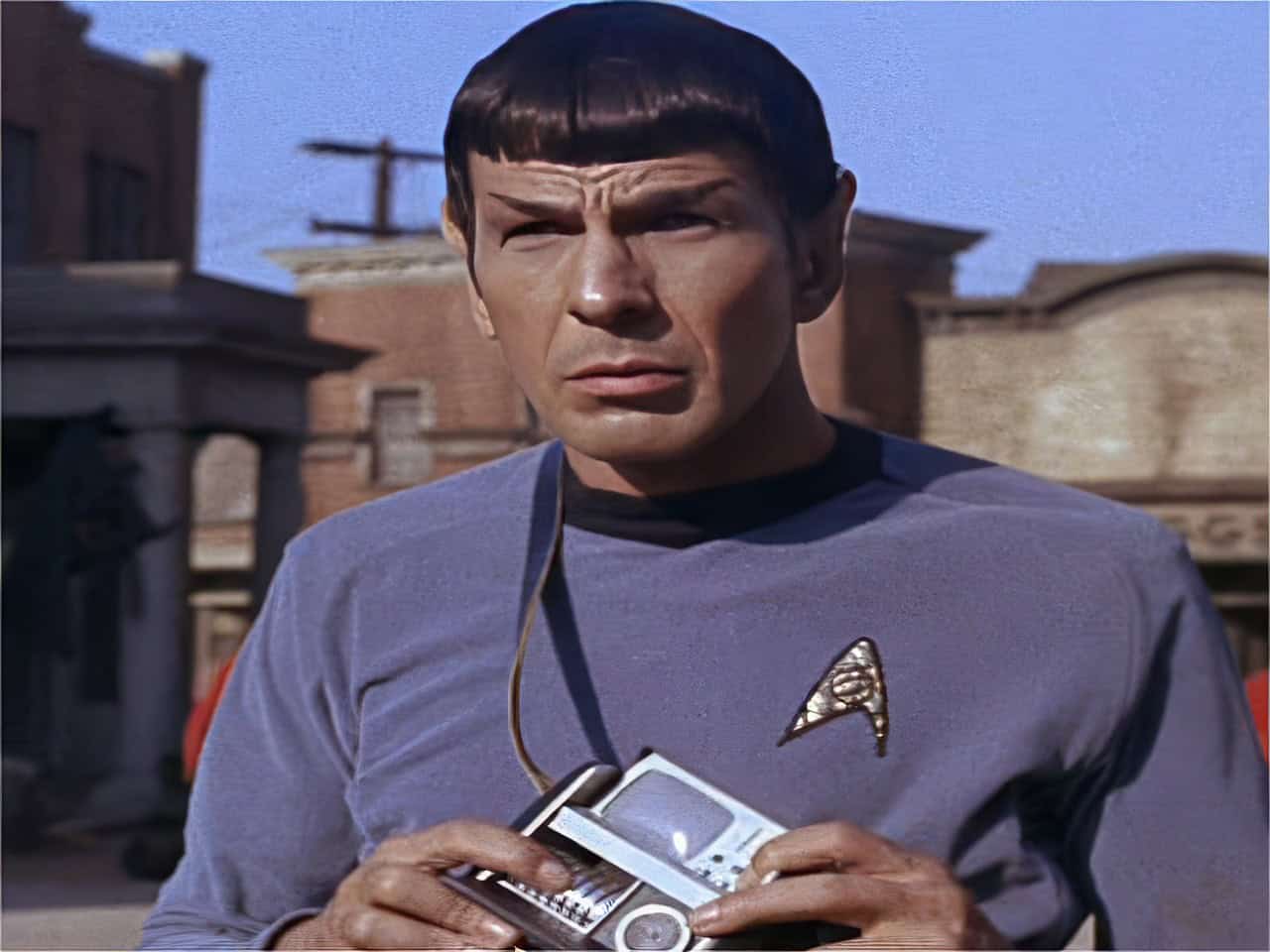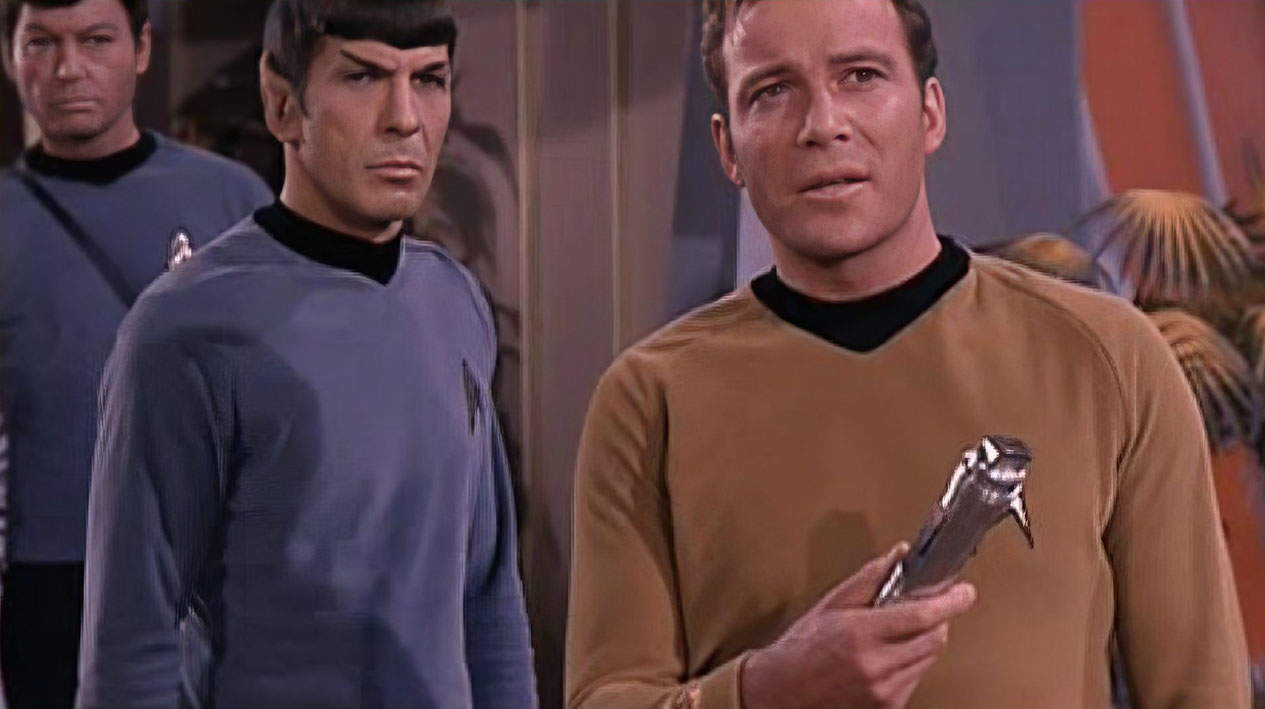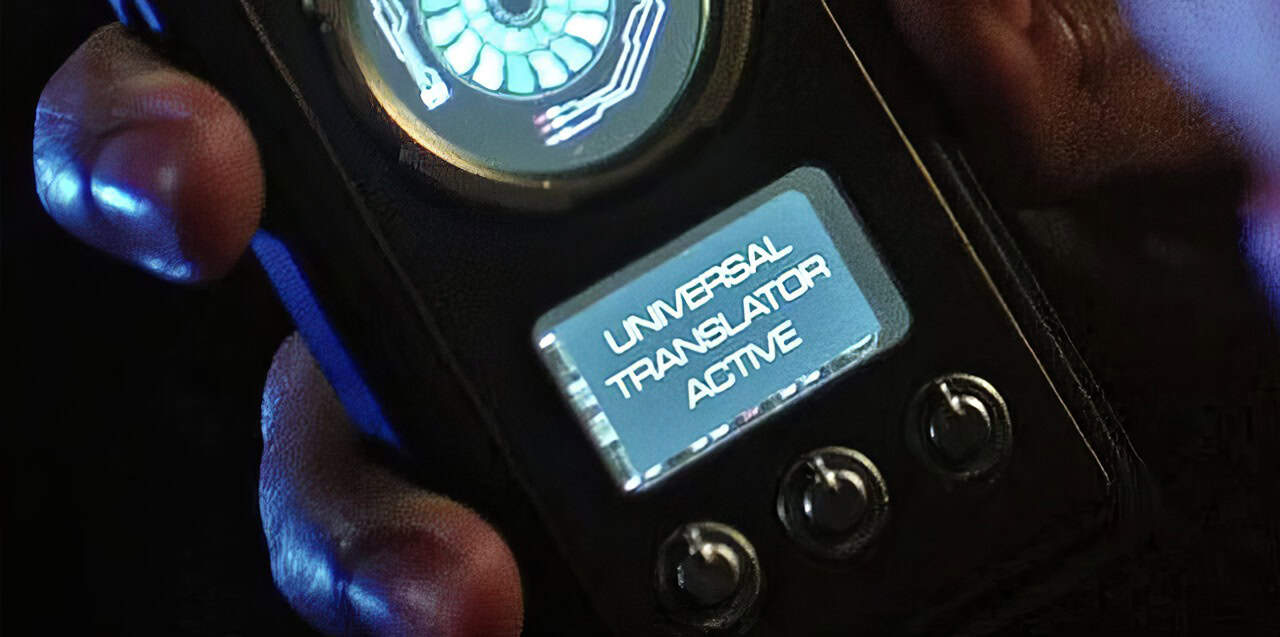The Universal Translator in Star Trek revolutionized interspecies communication. This fictional device broke language barriers, allowing instant understanding across alien races. 3 Today’s tech giants are racing to create real-world equivalents.
Google Translate now supports 108 languages, offering text and spoken translations in real-time. 2
As a veteran sci-fi analyst, I’ve tracked the evolution of translation tech for 15 years. The gap between fiction and reality is closing fast. AI and machine learning are pushing the boundaries of what’s possible.
Will we soon have our own universal translators? Let’s explore. 1
Key Takeaways
Star Trek’s Universal Translator inspired real-world tech like Google Translate, which now supports 108 languages for text and speech translation.
The fictional device uses advanced AI to decode alien languages instantly by analyzing brain waves, speech patterns, and non-verbal cues.
Current translation tech like Google’s Neural Machine Translation (2016) and Microsoft’s Z-code model (2020) are closing the gap between fiction and reality.
Real-world devices still struggle with idioms, context, and non-verbal communication, unlike Star Trek’s near-perfect Universal Translator.
Future innovations in AI, quantum computing, and neurolinguistic interfaces could lead to universal translators that enable communication with extraterrestrial life forms.
Table of Contents
Overview of the Universal Translator in Star Trek

The Universal Translator in Star Trek is a device that breaks language barriers. It lets crew members talk to aliens without learning their languages.
Concept and Functionality
Universal Translators in Star Trek interpret alien languages instantly. They scan brain wave frequencies, identifying universal concepts for real-time translation. 2 UTs focus on humanoid brain patterns, struggling with non-humanoid lifeforms.
This fictional device inspired real-world tech like the X1 AI Interpreter Hub, currently the best translation device available. 1
Darmok and Jalad at Tanagra – a phrase that stumped even the Universal Translator.
Star Trek’s UT operates via combadges or implants. It decodes linguistic patterns, idioms, and cultural nuances. The device’s functionality extends beyond mere word-for-word translation, grasping context and intent.
Federation officers rely on UTs for diplomatic missions, first contact scenarios, and daily communications with diverse species.
Role in the Star Trek Universe
The Universal Translator (UT) serves as a crucial plot device in Star Trek, enabling seamless communication across diverse species. It’s built into Starfleet combadges by the 24th century, allowing instant translation of any language. 2 This tech breaks down barriers, facilitating diplomacy, trade, and exploration throughout the galaxy. In everyday settings like the Enterprise’s Ten Forward lounge, the UT enables crew members from various backgrounds to interact freely, enhancing camaraderie and understanding.
In the Trek universe, UTs handle complex linguistic challenges, from Klingon to Tamarian metaphors. 3 They’re essential for First Contact scenarios and foster understanding between vastly different cultures.
Without UTs, many of Star Trek’s iconic interactions – from Picard’s negotiations to Kirk’s diplomatic missions – would be impossible, underlining their significance in the franchise’s narrative framework.
History of the Universal Translator

The Universal Translator first appeared in Star Trek’s original series. It evolved from a handheld device to an implant in later shows.
Initial Representations
Star Trek’s universal translator first appeared in the Original Series episode “Metamorphosis” (1967). It started as a handheld device, later evolving into a built-in feature of communicators.
By the 2230s, Starfleet communicators could translate 1,000 locally stored languages – a significant leap from early models. 4 This tech allowed characters to communicate across species barriers, bridging linguistic gaps in the vast Star Trek universe.
The concept drew inspiration from real-world language translation efforts. It reflected the optimism of the 1960s space race era, imagining a future where communication barriers vanished.
As the series progressed, the universal translator’s capabilities expanded, mirroring advancements in natural language processing and artificial intelligence. 2 The next step in its development saw integration into more advanced systems.
Development across Series
The Universal Translator evolved significantly across Star Trek series. Its development reflects advancements in both fictional technology and real-world language processing.
- Original Series (1960s): Handheld device, limited capabilities
- Next Generation (1980s-90s): Integrated into comm badges, more seamless . 2
- Deep Space Nine (1990s): Enhanced for diverse alien languages
- Voyager (1990s-2000s): Improved for Delta Quadrant species
- Enterprise (2000s): Prototype versions, showing early development
- Discovery (2010s): Advanced AI-driven translation
- Picard (2020s): Near-instantaneous translation of complex languages
These advancements mirror real-world progress in machine translation and AI. The next section explores the technological insights behind the Universal Translator. 5
Technological Insights on the Universal Translator

The Universal Translator in Star Trek uses advanced AI to decode alien languages in real-time. It analyzes speech patterns, contextual clues, and non-verbal cues to bridge communication gaps between species.
Operational Mechanics: Fiction versus Reality
Star Trek’s Universal Translator (UT) operates through advanced linguistic algorithms and neural networks. In reality, current translation tech relies on machine learning and vast language databases. 7 The UT instantly decodes alien languages, while modern devices need pre-programmed data. Star Trek’s version also handles non-verbal cues and alien concepts seamlessly. 6
Fictional UTs process brain waves to translate thoughts directly. Real-world devices can’t read minds yet. In 2293, Chekov and Uhura manually translated Klingon, showing UTs aren’t foolproof.
Today’s tech struggles with idioms, context, and nuanced meanings across cultures. The gap between fiction and reality narrows, but true universal translation remains a frontier for innovators.
The Universal Translator is the linguistic equivalent of warp drive – it breaks down barriers we once thought impassable.
Comparisons to Current Technologies
Current translation tech pales in comparison to Star Trek’s Universal Translator. Let’s examine the differences:
| Feature | Universal Translator | Current Tech |
|---|---|---|
| Language Support | All known languages | 108 languages (Google Translate) |
| Real-time Translation | Instantaneous | Near real-time (Google Pixel Buds, Timekettle) |
| Form Factor | Integrated into communicator | Smartphone apps, earbuds |
| Accuracy | Near-perfect | Varies, often imperfect |
| Context Understanding | Advanced | Limited |
| Non-verbal Communication | Capable | Not supported |
While impressive, our tech still faces hurdles in non-verbal communication. Let’s explore these challenges next. 28
Challenges with the Universal Translator
Translating alien languages poses unique hurdles. Non-verbal cues and cultural nuances often get lost in translation.
Language and Dialect Barriers
Language barriers present significant challenges for universal translators. Different languages have unique structures, idioms, and cultural nuances. Dialects add complexity, with regional variations in vocabulary and pronunciation.
The ‘Darmok’ episode of Star Trek: The Next Generation highlights this issue. It showcases a species that communicates entirely through metaphors, stumping the Enterprise’s universal translator. 8
The river Temarc in winter.
Overcoming these hurdles requires advanced linguistic analysis and cultural context understanding. Non-verbal cues, like body language and tone, also play crucial roles in communication.
These elements often don’t translate directly between species or cultures. The next challenge lies in communicating with non-humanoid species, which may use entirely different methods of expression. 9
Handling Non-verbal Communication
Beyond language barriers, non-verbal cues present unique challenges for universal translators. Facial expressions, gestures, and body language vary across cultures and species. UTs must interpret these subtle signals accurately.
Star Trek’s devices tackle this issue through advanced sensors. They analyze brain wave frequencies to decode universal concepts behind non-verbal communication. This allows for seamless translation of both spoken words and unspoken meanings.
The technology promotes universal peace by bridging gaps in interspecies understanding. 10
A Star Trek universal translator converts spoken language into the language of the user. Current technologies can recognize written or spoken language and interpret it accordingly. 11
Communicating with Non-Humanoid Species
Alien languages pose unique challenges for universal translators. Non-humanoid species might use sounds, colors, or even chemical signals to communicate – far beyond our usual speech patterns.
Engaging with Alien Languages
Alien languages present unique challenges for universal translators in Star Trek. Starfleet’s technology must adapt to various communication methods and linguistic structures.
- Metaphor-based languages: The Tamarian language, featured in “Darmok,” relies on cultural references and metaphors. Universal translators struggle with context-dependent meanings.
- Non-verbal communication: Species like the Breen use modulated electromagnetic emissions. Translators need specialized sensors to detect and interpret these signals.
- Telepathic languages: Betazoids and Vulcans can communicate thoughts directly. Translators must interface with neural patterns to convey meaning.
- Multi-dimensional languages: Some species use time or spatial dimensions in their speech. Translators require advanced algorithms to process these complex structures.
- Biological languages: The Borg’s nanoprobe-based communication system poses unique translation hurdles. Specialized bio-neural interfaces are necessary for accurate interpretation.
- Tonal languages: Klingonese uses pitch and intonation to convey meaning. Translators must precisely analyze audio frequencies for accurate translations.
- Gestural languages: Species like the Tak Tak rely heavily on body language. Visual recognition software becomes crucial for proper translation.
- Chemical communication: Certain species use pheromones or other chemical signals. Translators need advanced olfactory sensors to detect and interpret these messages.
Modifications for various life forms require specialized hardware and software adaptations.
Modifications for Various Life Forms
The Universal Translator’s adaptability to diverse life forms is crucial for interspecies communication. Engineers have developed several modifications to enhance its functionality across various alien physiologies. 14
- Subspace frequency adjustments for non-corporeal beings
- Bio-neural interface for telepathic species like Betazoids
- Olfactory sensors for pheromone-based languages
- Gravitational field modulators for silicon-based life forms
- Quantum entanglement processors for time-shifted communications
- Holographic projectors for species using visual languages
- Tachyon emission detectors for faster-than-light conversations
- Radiation spectrum analyzers for energy-based entities
- Nanoscale vibration sensors for microscopic life forms
- Multidimensional matrix converters for beings from alternate realities 15
The Future of Translation Devices
Real-time translation tech is getting better fast. Soon, we might chat with anyone, no matter what language they speak.
Innovations in Universal Translation
Google’s Neural Machine Translation system revolutionized language processing in 2016. It uses deep learning to understand context and nuance, improving accuracy by 60%. 2 Microsoft’s Z-code model, introduced in 2020, can translate between 100 languages without English as an intermediary.
These advancements bring us closer to Star Trek’s Universal Translator concept. 16Timekettle WT2 Edge earbuds offer real-time translation for 40 languages and 93 accents. They employ AI to reduce background noise and enhance speech recognition. The TARDIS-like telepathic field remains science fiction, but current tech bridges communication gaps.
Voice recognition, motion compensation, and semantic analysis continue to evolve, pushing the boundaries of universal translation.
Impact on Interspecies Communication
Universal translators could revolutionize interspecies communication. These devices might decode alien languages, gestures, and even non-verbal cues. Imagine conversing with extraterrestrial life forms as easily as chatting with a neighbor.
The technology could foster galactic diplomacy, scientific collaboration, and cultural exchange. It’d break down barriers between vastly different civilizations, potentially leading to unprecedented peace and understanding across the cosmos. 2
Star Trek’s vision of seamless communication might become reality. Advanced AI and machine learning could tackle complex linguistic challenges. Quantum computing might process vast language databases instantly.
Neurolinguistic interfaces could directly interpret brain signals. These innovations promise to bridge gaps between humans and alien species, opening doors to new frontiers of knowledge and cooperation. 14
People Also Ask
What is the Star Trek Universal Translator?
It’s a fictional device in Star Trek that instantly translates alien languages. Captain Kirk, Riker, and others use it for communication across species.
How does the Universal Translator work in Star Trek?
It analyzes brain waves and language patterns to provide real-time translation. The device works on various ships like Deep Space 9 and USS Dauntless.
Can the Universal Translator handle complex languages?
Yes. It’s shown translating Tamarian language in “Darmok” and Klingon in “Errand of Mercy”. Even handles telepathic communication.
Is there a real-world equivalent to the Universal Translator?
Microsoft Translator and other AI language tools are getting close. They’re not as advanced as Star Trek tech yet.
What challenges exist in creating a real Universal Translator?
Handling idioms, context, and cultural nuances is tough. The Tamarians in Star Trek use metaphors that confuse the translator.
How might a Universal Translator impact our world?
It could revolutionize international relations, trade, and cultural exchange. Might even help with interspecies communication if we meet aliens.
References
- ^ https://racodemia.wordpress.com/2019/01/17/the-tangled-philosophy-behind-star-treks-universal-translator/ (2019-01-17)
- ^ https://www.thecompanion.app/star-trek-science-universal-translator/ (2022-04-13)
- ^ https://memory-alpha.fandom.com/wiki/Universal_translator
- ^ https://www.youtube.com/watch?v=uW3o7PlQiA0
- ^ https://www.researchgate.net/publication/329143570_The_Evolution_of_the_Universal_Translator_Technical_Device_and_Human_Factor_in_Doctor_Who_and_Star_TrekFrom_the_1960s_to_the_Present_Chapter_1_in_D_Abend-David_ed_Representing_Translation_The_Represen
- ^ https://forum.rpg.net/index.php?threads/star-trek-ive-figured-out-how-universal-translators-work.736015/
- ^ https://builtin.com/machine-learning/universal-translator
- ^ https://www.linkedin.com/pulse/star-trek-tech-universal-translator-dave-west
- ^ https://www.ncbi.nlm.nih.gov/pmc/articles/PMC9525128/
- ^ https://www.pewresearch.org/internet/2018/12/10/improvements-ahead-how-humans-and-ai-might-evolve-together-in-the-next-decade/ (2018-12-10)
- ^ https://www.researchgate.net/publication/311995109_Universal_Translators_Now_You%27re_Speaking_My_Language
- ^ https://www.trekbbs.com/threads/how-can-a-universal-translator-work-without-prior-contact-to-species-language.300783/
- ^ https://www.space.com/meti-could-we-communicate-with-intelligent-aliens (2024-01-17)
- ^ https://www.startrek.com/news/how-artificial-intelligence-is-getting-us-closer-to-star-treks-universal-translators (2019-11-20)
- ^ https://scifi.stackexchange.com/questions/60851/universal-translator-sometimes-working-instantly-sometimes-not-at-all
- ^ https://www.newyorker.com/books/page-turner/star-trek-google-and-the-dream-of-universal-translation (2011-01-26)




